Celebrations Aren’t Complete without Kolaches in Spillville
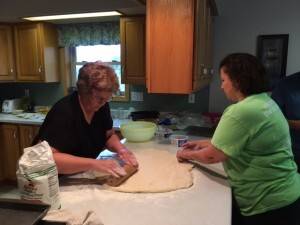 It’s a tradition for many American families to say what they’re thankful for as they gather around the dining room table to feast on turkey, cranberries and pumpkin pie. It’s also a tradition for families of Slovakian decent to enjoy kolaches (koh-la-chees) when gathering for the holidays.
It’s a tradition for many American families to say what they’re thankful for as they gather around the dining room table to feast on turkey, cranberries and pumpkin pie. It’s also a tradition for families of Slovakian decent to enjoy kolaches (koh-la-chees) when gathering for the holidays.
The famous Czech kolache is a sweet dough pastry with a sweet filling. If you’ve never tasted one before, you don’t know what you’re missing! And if you’ve never before visited the small Northeast Iowa town of Spillville, you’re in for a real treat.
Plan a fall road trip to coincide with the annual fall church bake sale or another one of the local kolache baking festivals, which take place at Saint Wenceslaus Catholic Church during September, October and November. You can distinguish kolaches from the Spillville area by their unique bow tie on top.
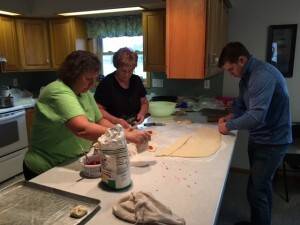 Be sure to place your order early as only 350 dozen – yes, 350 dozen – will be handmade by parishioners inside the United States’ oldest continuously operated Catholic Bohemian church. Every dozen is pre-sold.
Be sure to place your order early as only 350 dozen – yes, 350 dozen – will be handmade by parishioners inside the United States’ oldest continuously operated Catholic Bohemian church. Every dozen is pre-sold.
Kolache baking is a community affair. Dough preparation begins at 3 AM, and the first shift of volunteers comes to work at 5 AM. Assembly lines form to roll out the dough, cut it into squares, fill the pastry, fold the dough over the filling and then bake the kolaches until they’re perfectly golden brown.
Earlier this fall I had an opportunity to road trip to Spillville for a behind-the-scenes baking experience that I’ll never forget. Easton Kuboushek, whom I’ve gotten to know through my 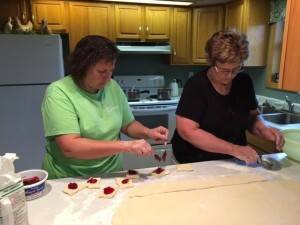 involvement with the Iowa Soybean Association, told me about the kolache tradition in his hometown.
involvement with the Iowa Soybean Association, told me about the kolache tradition in his hometown.
My schedule didn’t allow me to attend the fall craft and bake sale, so the Kuboushek family graciously hosted me for a baking day. You know you’re meeting a serious baker when a KitchenAid® mixer isn’t big enough for the job!
“There’s a few ladies around here who have mixers that big,” chuckled Easton’s grandpa, Leonard, as he watched our baking crew. “You should ask her how much that darn thing costs!”
Easton’s grandma, Betty, thoughtfully measured each ingredient with the efficiency of any celebrity 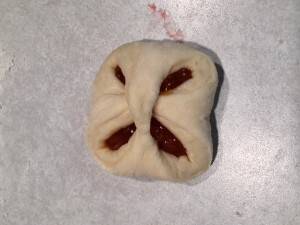 baker on Food Network while patiently answering my questions. Once the dough was mixed and left to rise, I got a VIP tour of the town from Easton and his mom, Kristi.
baker on Food Network while patiently answering my questions. Once the dough was mixed and left to rise, I got a VIP tour of the town from Easton and his mom, Kristi.
I just loved how the beautiful St. Wenceslaus church remains the center of the town. Completed in 1860 by hardworking Czech settlers, this church has been beautifully preserved. The original pipe organ, which was installed in 1876, remains. It’s the same that organ was played by Antonin Dvorak, during his three-month stay in Spillville, shortly after he had written “New World Symphony.”
Dvorak wrote Opus 96: “Quartet in F Major” and Opus 97: “Quintet in E Flat Major” inside the St. Wenceslaus Old School, which his the oldest Czech parochial school in America. A fixture in 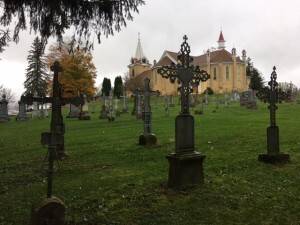 Spillville for more than 135 years, the Old School was used for over 75 years as home for teaching nuns that served in the parish. It also has been used as a boarding house for rural students and as a community hall.
Spillville for more than 135 years, the Old School was used for over 75 years as home for teaching nuns that served in the parish. It also has been used as a boarding house for rural students and as a community hall.
Another point of interest in downtown Spillville is the Bily Clock Museum. The master craftsmanship of the Bily brothers is phenomenal. Honestly, words alone can’t do justice to these works of art! (Click here for a news video that gives you a virtual tour of the 20 wooden clocks. The largest clock, called the Apostle’s parade, stands nine feet, 10 inches tall. It’s carved from walnut, hard maple, cherry and rosewood.) I also learned many interesting facts on the docent-led tour, including the fact that Easton’s parents are raising their children on what used to be the Bily brothers’ farm. How cool is that?
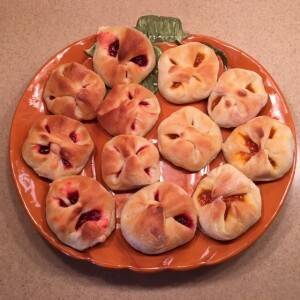 After touring Spillville, it was time to return to Betty Kubouskeh’s kitchen and to the task at hand. Betty and Kristi rolled the dough. After it was cut into squares, Easton and I helped fold the dough over the filling. Kolaches come in a variety of sweet and savory fillings. Favorites in the Kuboushek household are raspberry, apricot, prune and poppy seed. (I’ll admit that I couldn’t pick a favorite between apricot and raspberry. They’re both equally delicious IMO.)
After touring Spillville, it was time to return to Betty Kubouskeh’s kitchen and to the task at hand. Betty and Kristi rolled the dough. After it was cut into squares, Easton and I helped fold the dough over the filling. Kolaches come in a variety of sweet and savory fillings. Favorites in the Kuboushek household are raspberry, apricot, prune and poppy seed. (I’ll admit that I couldn’t pick a favorite between apricot and raspberry. They’re both equally delicious IMO.)
“I never used to like the poppy seed, but after baking these for 57 years, I love them!” laughed Betty.
Special thanks to Betty Kuboushek for opening her home to me and for treating me to the most delicious home-cooked meal including pumpkin pie for dessert! It’s the people like Betty, Kristi and Easton who make my job a true privilege.
Thanks also to the Kuboushek family for sharing a recipe from the church cookbook for kolaches. Perhaps baking kolaches can become a new holiday tradition for your family, too!
Kolaches
Ingredients
6 egg yolks & 2 whole eggs
1 c. (2 sticks) butter
1 c. lard
1 1/2 c. sugar
1/3 c. mashed potato granules
2 1/2 T. salt
1/3 c. Instant active dry yeast
2 c. powdered milk
8 c. hot water
20 c. flour (maybe 1/3 c. more)
Instructions
Beat eggs, butter, lard and sugar. Add potatoes, dissolved in 1 1/2 cups of very hot water; beat again. Dissolve the powdered milk and salt in 6 1/2 cups hot water, and add to mixture. Put all together in bowl; mix with mixer with 16 cups flour and the yeast. Beat for 3 minutes. Add 4 more cups flour and beat 6 more minutes. Put in a large, greased, stainless steel bowl; cover with plastic wrap. Let rise 1/2 hour. Punch down and let rise another 1/2 hour. Put onto breadboard and shape. I bake between 8 1/2 to 9 minutes at 400 degrees Fahrenheit. When baked, crush with melted butter. Makes 12 dozen (big batch).